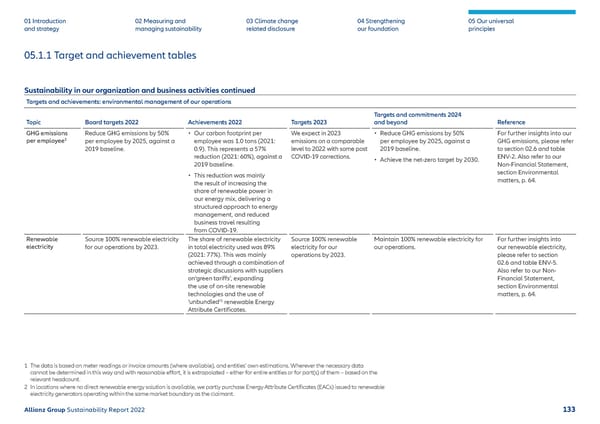01 Introduction and strategy 02 Measuring and managing sustainability 03 Climate change related disclosure 04 Strengthening our foundation 05 Our universal principles 05.1.1 Target and achievement tables Sustainability in our organization and business activities continued Targets and achievements: environmental management of our operations Topic Board targets 2022 Achievements 2022 Targets 2023 Targets and commitments 2024 and beyond Reference GHG emissions per employee 1 Reduce GHG emissions by 50% per employee by 2025, against a 2019 baseline. • Our carbon footprint per employee was 1.0 tons (2021: 0.9). This represents a 57% reduction (2021: 60%), against a 2019 baseline. • This reduction was mainly the result of increasing the share of renewable power in our energy mix, delivering a structured approach to energy management, and reduced business travel resulting from COVID-19. We expect in 2023 emissions on a comparable level to 2022 with some post COVID-19 corrections. • Reduce GHG emissions by 50% per employee by 2025, against a 2019 baseline. • Achieve the net-zero target by 2030. For further insights into our GHG emissions, please refer to section 02.6 and table ENV-2. Also refer to our Non-Financial Statement, section Environmental matters, p. 64. Renewable electricity Source 100% renewable electricity for our operations by 2023. The share of renewable electricity in total electricity used was 89% (2021: 77%). This was mainly achieved through a combination of strategic discussions with suppliers on’green tariffs’, expanding the use of on-site renewable technologies and the use of ‘unbundled’ 2 renewable Energy Attribute Certificates. Source 100% renewable electricity for our oper ations by 2023. Maintain 100% renewable electricity for our operations. For further insights into our renewable electricity, please refer to section 02.6 and table ENV-5. Also refer to our Non- Financial Statement, section Environmental matters, p. 64. 1 The data is based on meter readings or invoice amounts (where available), and entities’ own estimations. Wherever the necessary data cannot be determined in this way and with reasonable effort, it is extrapolated – either for entire entities or for part(s) of them – based on the relevant headcount. 2 In locations where no direct renewable energy solution is available, we partly purchase Energy Attribute Certificates (EACs) issued to renewable electricity generators operating within the same market boundary as the claimant. Allianz Group Sustainability Report 2022 133
 Sustainability Report 2022 | Allianz Page 133 Page 135
Sustainability Report 2022 | Allianz Page 133 Page 135